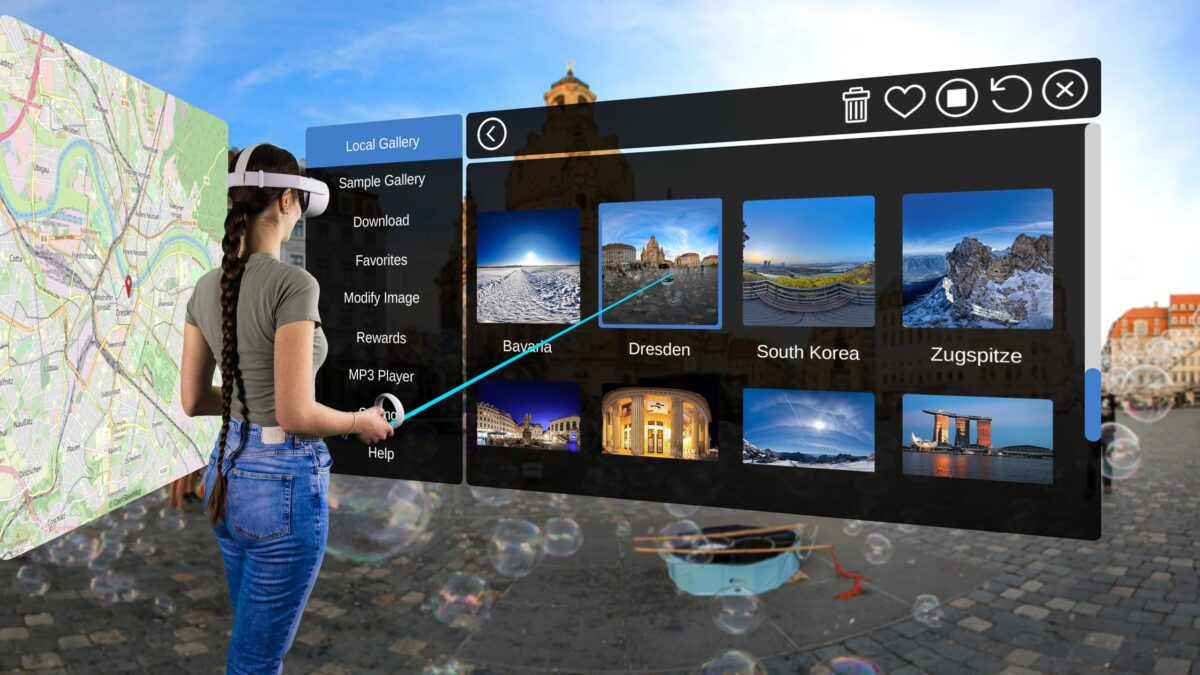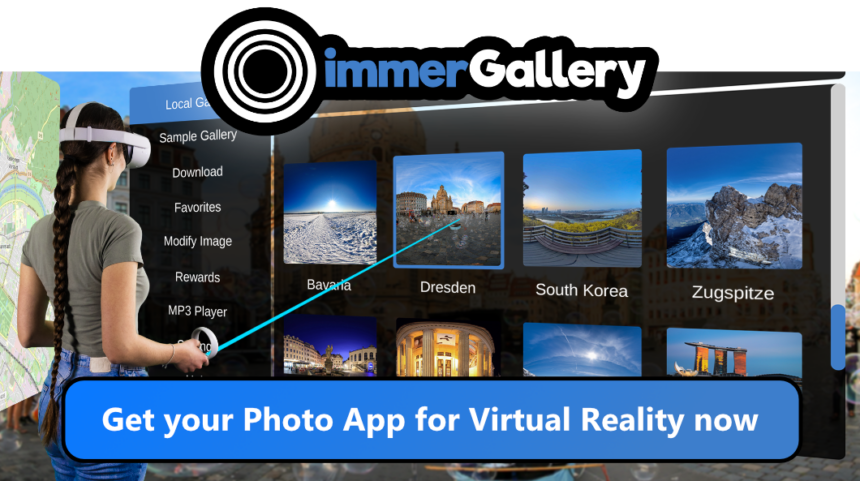Meta Quest 2: immerGallery - VR photo gallery app review

Version 1.1
ImmerGallery is an image viewer for Meta Quest 1 and 2 that lets you view VR and 2D images in virtual reality more easily.
I tested immerGallery for the first time in April 2022. A lot has happened since then: Existing functions have been improved and expanded, and new features have been added. Time to take another look at the photo app.
Content
immerGallery: Review in a nutshell
ImmerGallery fills a gap in the market. If you love photography and want to view 2D and VR images in virtual reality, you can't get around this VR app. However, importing images is still a bit inconvenient and the platform aspect is expandable.
immerGallery is useful for me if…
- you are a (hobby) photographer or love pictures and want to view them in Virtual Reality,
- want to create (immersive) photo galleries for you as well as your family and friends and
- want to see the potential of immersive photos (3D, VR) using sample galleries.
immerGallery is less useful for me if…
- you are not familiar with Sidequest, Dropbox and UPnP,
- expect a packed photo sharing platform and
- want to watch videos.
What is immerGallery?
ImmerGallery is a VR app for Meta Quest 1 & 2 that specializes in recognizing and displaying images of any kind.
Supported formats are:
- 2D formats
- VR formats: 180- and 360-degree, mono- and stereoscopic
- 3D images in rectangular format
ImmerGallery also allows you to create immersive stories using a web tool. Users can create sequences of images and add soundtracks and animated environmental effects.
It is intended that immerGallery will become a platform where users can share and download self-hosted images. However, the VR app is still far from being Instagram for VR. To date, the platform features are pretty basic at this point.
The VR app is not intended for displaying videos. There are already special VR apps for this in the Meta Store.
There is a free demo of immerGallery if you want to try out the basic functions or experience great examples of 3D and VR photography before you buy.
Which features is immerGallery offering?
Below you will find the most important features including version 1.1, which was released on September 12, 2022.
- Wide support for VR cameras: An overview of supported cameras and image formats is available on the official website (scroll down to the FAQ).
- Automatic image format recognition: Whether 2D, 3D or VR, immerGallery recognizes the vast majority of image formats and displays the images correctly without you having to bother with format settings. The image format detection can be switched off for individual images if necessary, and the image format can be set individually. Alternatively, you can force image format detection by adding suffixes to the file names (see PDF overview).
- Optimal presentation of 2D and VR images: Software tricks ensure a razor-sharp image with minimal flickering.
- Moveable 2D screen: The 2D screen can be moved back and forth with the thumb stick. Further adjustments are possible via settings.
- Comfort options: Thanks to Snap-Turn for immersive images, you can rotate 360-degree images by pressing a button and that way enjoy them from all angles, even on the couch. In the settings, the viewing angle can be tilted vertically, so you will be able to watch pictures in bed or lying on the couch.
- Immersive Stories: Use a web tool to create autoplaying photo galleries with soundtracks (background music, narrator voice) and animated environmental effects (rain, snow, meadow with butterflies, pollen, and dust).
- UPnP/DLNA support (beta): This feature, which is still in beta, allows you to stream pictures to the VR headset via your Wi-Fi network. The corresponding option can be found in the settings.
- Ambient and audio effects for images: You can breathe life into images by adding ambient effects (see) as well as soundscapes.
- Bookmarks: You could set individual images or folders as bookmarks to find them easily again.
- Show GPS coordinates and other JPG metadata: This includes camera model, lens, aperture, and shutter speed. Speaking of GPS, you can show a map that displays where a photo was taken. The picture currently still has to be created manually.
- One-controller controls: you can put the second controller aside.
- Sample Galleries: The VR app includes a variety of galleries that demonstrate the characteristics of different formats, including 3D photos, 180-degree shots with Canon's VR lens, extremely high-resolution stereoscopic 360-degree images, and drone panoramas. The demo includes these as well and is worth downloading for that reason alone.
- If you want to know exactly what has been done in the last few months, take a look at the release notes.
ImmerGallery Hands-on: What is immerGallery capable of?
Photography fascinates me. I've been collecting and archiving digital photos from a variety of sources, including VR cameras, for more than 20 years.
It's not just immersive images that benefit from Virtual Reality; even 2D photos can have a new impact when viewed in the monumental large format that VR makes possible. As a result, you can sometimes see details that you wouldn't have noticed before.
ImmerGallery fills a gap in the market as a VR-specific image viewer. And it now works excellently: While the VR app did not recognize all photo formats by far in my first test in April, these concerns have meanwhile been resolved. In the latest test, immerGallery no longer had any problems recognizing and correctly displaying my randomly selected images.
One exception are the 180-degree photos of my Insta360 EVO, which are presented suboptimally. I have to export the pictures from the proprietary INSP format to the JPG format with Insta360 Studio first. Thereafter, the presentation works fine.
If you are uncertain whether immerGallery recognizes all your photos and is worth buying, you can download the demo of the VR app. The free demo version recognizes and displays the first ten images in the Pictures folder.
The biggest issue I encountered with immerGallery in spring was the inconvenient transfer of pictures to Meta Quest 2. The import is still not solved optimally, but there are now several options, including streaming via UPnP.
Version 1.1 offers the following options:
- Transfer via USB cable: Connect the Meta Quest to the computer where your images are stored and then transfer them directly or via Sidequest to the folders of the VR headset, which are recognized by immerGallery. A video guide illustrates the procedure.
- Transfer via Meta Quest Browser and Dropbox: Go to the Dropbox website in the Meta Quest Browser, log in to your account, and then download individual images or entire folders and subfolders to the VR headset. They will then appear in the "Download" folder. A video guide illustrates the procedure.
- Transfer via UPnP: The streaming feature is still in beta and can currently lead to problems. One disadvantage of this option is that immersive stories cannot be streamed to Meta Quest 2.
- Transfer via Gallery Download: Version 1.1 brings the ability to download galleries stored online. To achieve this, you must enter the corresponding URL.
Great potential: My feature wish list
These options are sufficient for hobby photographers and technically savvy casual users, but they are still too complicated for a broad audience.
It would be cool, for example, if you could stream photos from your smartphone directly into the VR headset and display them in large format in immerGallery. Meta's discontinued VR app Oculus Gallery offered this feature a few years ago. The question is whether Meta, Google or Apple even offer the appropriate interface for such a function.
I see the greatest future potential in immerGallery as a platform. The gallery download is to evolve into a feed, developer and immerVR founder Daniel Pohl tells me. The idea is that you can subscribe to and download content from other users and share your own content, which would make immerGallery a platform for immersive images. Then the VR app would become interesting because of its user-generated content, too, and not just as a personal image viewer.
I also like the idea of immersive stories: Several connected VR images together with a soundtrack could become a new storytelling medium. However, this would require a more engaging app than the current web tool. How about a smartphone app?
Also on my wish list:
- A passthrough mode for 2D photos, so that you stay aware of your surroundings while looking at images,
- a more flexible presentation of 2D photos (it would be great if you could grab the images and place them freely in space),
- hand tracking support,
- a better interface that is more Virtual Reality friendly (the 2D windows and laser pointer controls are functional, but dull and old-fashioned) and,
- automatic AI upscaling of 2D and VR images.
I hope that as VR headset adoption increases, cheaper and better VR cameras will hit the market in the coming years. Currently, very little is happening, especially in the consumer segment, unfortunately.
If that changes, Virtual Reality will need VR apps like immerGallery to view and share immersive images.
You can get immerGallery here:
| Version | Store | Price |
|---|---|---|
| ImmerGallery | App Lab | 14,99 Euro |
| ImmerGallery Demo | App Lab | Free |
Note: Links to online stores in articles can be so-called affiliate links. If you buy through this link, MIXED receives a commission from the provider. For you the price does not change.
